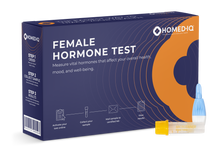Lauren is a health scientist and science communicator currently living in the Netherlands. Originally from Canada, she completed a Research Master’s in Health Sciences at the Netherlands Institute of Health Sciences at Erasmus University Rotterdam (NIHES) with a specialisation in epidemiology. Prior to her master’s degree, she completed a Bachelor’s degree in Health Sciences at Simon Fraser University. With a background in public health, her goal is to create accurate scientific content that is easy to understand and empowers people to make informed decisions. Within Homed-IQ, Lauren works as a Product Developer and Content Lead, working closely with physicians and scientists on medical devices for Homed-IQ’s new products and written communications.
What is oral HPV?
Human papillomavirus (HPV) is a virus that is transmitted through sexual contact. HPV is the most common sexually transmitted infection (STI) in the world, with more than 80% of sexually active people being infected with at least one type of HPV in their lifetime (WHO, 2017). Most HPV infections resolve themselves without treatment within two years. In some cases, HPV infections remain in the body for a long time and can lead to cancer. HPV is most commonly known for causing cervical cancer, but a long-term infection can also cause cancers of the anus, vagina, vulva, penis, and the back of the throat (oropharynx). An HPV infection in the mouth is also known as oral HPV. This blog will explain what oral HPV is, how it occurs, and how to prevent it.
Table of Contents
- What is HPV?
- How is oral HPV transmitted?
- Oral HPV and cancer
- How common is oral HPV?
- What are the symptoms of oral HPV?
- Treatment for oral HPV
- Preventing oral HPV
- Does oral HPV mean cancer?
What is HPV?
HPV is a common group of viruses of which there are more than 200 types. Approximately 40 types of HPV can affect the mouth or genital areas (CDC, 2022). “Low-risk” HPV types can cause genital warts while “high-risk” HPV types can cause cancers of the genitals and oropharynx. There are 14 high-risk types of HPV, including HPV 16, 18, 31, 33, 35, 39, 45, 51, 52, 56, 58, 59, 66, and 68 (NCI, 2023). HPV types 16 and 18 are responsible for most HPV-related cancers and are considered the highest risk.
How is oral HPV transmitted?
You can get HPV by having vaginal, anal, or oral sex with someone who has the virus, or from intimate touching (CDC, 2022). Unlike STIs that are spread through body fluids such as semen or blood, HPV is transmitted through skin-to-skin contact. This means an infection can occur even if condoms are used. It is possible for someone with HPV to pass the infection to others even if they are having no symptoms, which is one of the reasons why it is so common. Oral HPV can be transmitted through oral sex and deep tongue kissing (French kissing) (UCSF Health, 2019).
Oral HPV and cancer
High-risk HPV can infect the mouth and throat and cause cancers of the oropharynx, which includes the back of the throat, base of the tongue, and tonsils. In recent years the prevalence of oropharyngeal cancer has been increasing in Europe, the US, and Canada (Mount Sinai, Habbous et al., 2017). It is estimated that HPV infections are responsible for 70% and 51% of all oropharyngeal cancers in the US and UK respectively (Lechner et al., 2022). Most of these cases are caused by HPV type 16.
In the past, oropharyngeal cancers were most often believed to be caused by smoking and heavy alcohol use. However, as the number of alcohol and tobacco-related cancers have declined, there has been an increase in oropharyngeal cancers associated with oral HPV infections (Yale Medicine). While the exact reason for the increase in oropharyngeal cancers is not yet understood, it is believed that an increased number of people engaging in sex with multiple partners and having oral sex are getting oral HPV infections, resulting in a higher rate of oropharyngeal cancers (Mount Sinai).
Testing for oral HPV
At this time there is no approved test for oral HPV (Johns Hopkins). In some research settings, oral swabs may be used to detect an oral HPV infection. Currently, vaginal swabs for HPV remain the only widely available HPV test. These tests detect high-risk forms of HPV associated with cancer, and not lower-risk types that may cause genital warts. A swab test for HPV is different from a Pap smear, which is a procedure in which cells are collected from the cervix and examined for cancerous or precancerous changes. Interested in performing a vaginal swab test for HPV from home? Try Homed-IQ’s HPV Test for Women.
Since HPV testing is limited to vaginal/cervical infections and these tests only detect high-risk HPV types, many people do not know they have HPV and pass it to others unknowingly. As such, vaccination against HPV is the best way to prevent high-risk genital or oral infections that can cause cancer.
How common is oral HPV?
The prevalence of oral HPV is not well understood because there is no widely available test for it. A 2012 American study of 5579 people aged 14 to 69 found that 10.1% of male participants and 3.6% of female participants tested positive for oral HPV (Gillison et al., 2012). A 2017 student found that 11.5% of US men and 3.2% of women have HPV, and estimated that men are 6 times more likely to have an oral HPV infection than women (Deshmukh et al., 2017).
What are the symptoms of oral HPV?
Most cases of oral HPV have no symptoms at all. This means many people have HPV without ever knowing it, allowing them to easily pass the infection to others (UCSF Health, 2019). Individuals with a low-risk oral HPV infection may develop sores or warts in or around their mouth. The HPV types that cause warts are not known to cause cancer (CDC, 2022). High-risk HPV has no symptoms. Symptoms of oropharyngeal cancer that may be associated with oral HPV include:
- Persistent sore throat
- Trouble swallowing
- Swollen lymph nodes
- Jaw pain or swelling
- Unexplained weight loss
- Earaches
- Hoarseness
Source: CDC, 2022
Treatment for oral HPV
HPV infections are usually naturally cleared by the body without treatment (Johns Hopkins). Apart from waiting for the infection to resolve on its own, there is no treatment or cure for high-risk oral HPV. If you have a low-risk oral HPV infection that causes warts in or around your mouth, you can have them removed by a doctor (Cleveland Clinic, 2022).
Preventing oral HPV
While there are no approved tests or treatments for oral HPV, there are some things you can do to reduce the risk of infection.
Practice safe sex: using a condom or dental dam every time you have sex (including oral sex) can reduce your risk of all STIs, including HPV. However, it is important to note HPV can infect areas that condoms do not cover, and safe sex does not guarantee 100% protection.
Limit your number of sexual partners: abstinence (not having sex) is the only way to 100% protect against HPV. Being in a mutually monogamous relationship (you only have sex with someone who only has sex with you) reduces your risk of exposure to HPV (CDC, 2021).
Get vaccinated against HPV: HPV vaccination protects against the most high-risk types of HPV and the most common low-risk types that cause genital warts. While the vaccine was initially offered to girls with the aim of preventing HPV-related cervical cancer, the vaccine also protects against high-risk HPV infections that can cause anal, vulvar, vaginal, penile, or oropharyngeal cancers in both women and men (CDC, 2022). In many countries, boys are now also included in HPV vaccination programs. In the Netherlands, boys and girls from the age of 10 are invited to be vaccinated against HPV (RIVM).
The HPV vaccine prevents new infections, but does not treat existing infections or cancers. This is why it is most effective if given before becoming sexually active. If not vaccinated as a child, it is also recommended that teenagers and adults are vaccinated up to the age of 26. Vaccination after age 26 is not recommended for everyone. Adults older than 26 may be vaccinated after discussing their risk of HPV and potential benefits with their doctor (CDC, 2022).
Does oral HPV mean cancer?
No. Oral HPV is not cancer, and most cases of HPV will go away on their own and not turn into cancer. However, certain types of high-risk HPV can turn into cancer over time if they do not leave the body, particularly HPV type 16 (Lechner et al., 2022). Getting vaccinated, practicing safe sex, and getting regular vaginalHPV testing/Pap smears if you are eligible are all ways to limit your risk of oral HPV.









